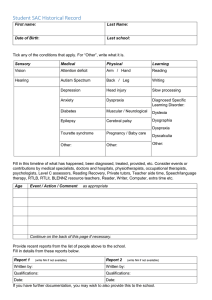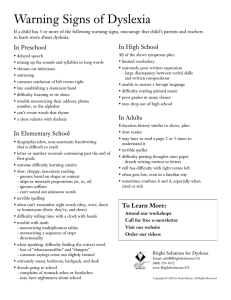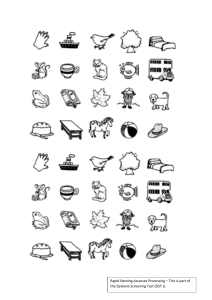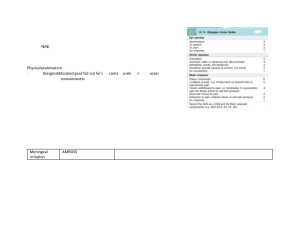Uploaded by
Edlyn Bacquian
Dyslexia, Dysgraphia, and Dyscalculia: Understanding Learning Disabilities
advertisement
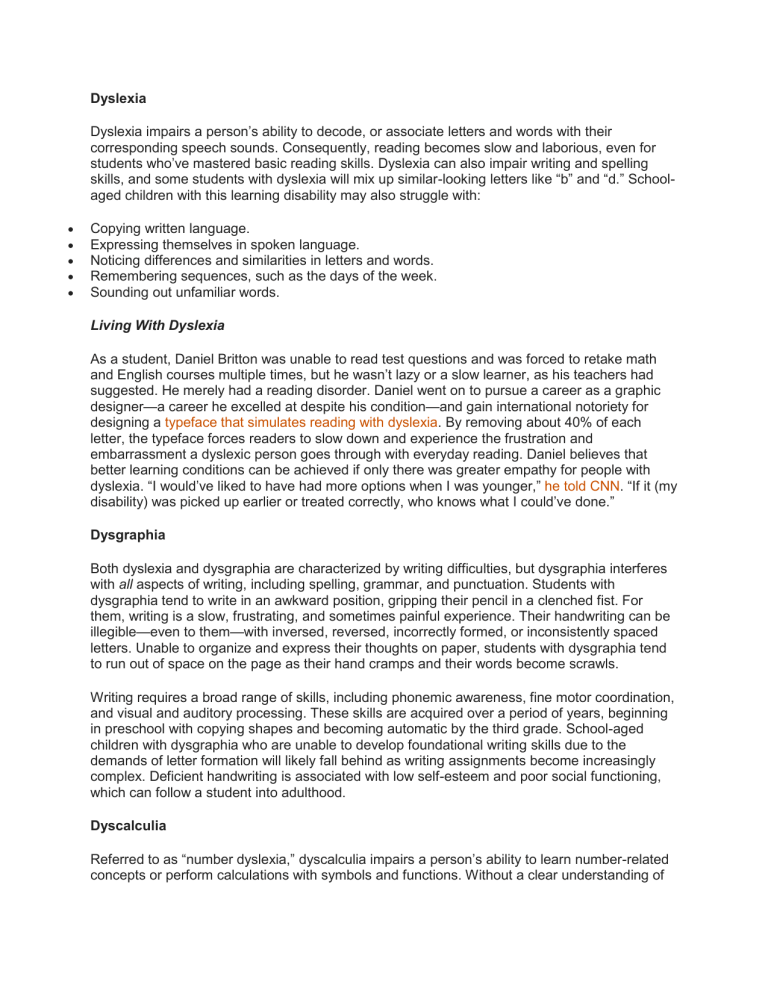
Dyslexia Dyslexia impairs a person’s ability to decode, or associate letters and words with their corresponding speech sounds. Consequently, reading becomes slow and laborious, even for students who’ve mastered basic reading skills. Dyslexia can also impair writing and spelling skills, and some students with dyslexia will mix up similar-looking letters like “b” and “d.” Schoolaged children with this learning disability may also struggle with: Copying written language. Expressing themselves in spoken language. Noticing differences and similarities in letters and words. Remembering sequences, such as the days of the week. Sounding out unfamiliar words. Living With Dyslexia As a student, Daniel Britton was unable to read test questions and was forced to retake math and English courses multiple times, but he wasn’t lazy or a slow learner, as his teachers had suggested. He merely had a reading disorder. Daniel went on to pursue a career as a graphic designer—a career he excelled at despite his condition—and gain international notoriety for designing a typeface that simulates reading with dyslexia. By removing about 40% of each letter, the typeface forces readers to slow down and experience the frustration and embarrassment a dyslexic person goes through with everyday reading. Daniel believes that better learning conditions can be achieved if only there was greater empathy for people with dyslexia. “I would’ve liked to have had more options when I was younger,” he told CNN. “If it (my disability) was picked up earlier or treated correctly, who knows what I could’ve done.” Dysgraphia Both dyslexia and dysgraphia are characterized by writing difficulties, but dysgraphia interferes with all aspects of writing, including spelling, grammar, and punctuation. Students with dysgraphia tend to write in an awkward position, gripping their pencil in a clenched fist. For them, writing is a slow, frustrating, and sometimes painful experience. Their handwriting can be illegible—even to them—with inversed, reversed, incorrectly formed, or inconsistently spaced letters. Unable to organize and express their thoughts on paper, students with dysgraphia tend to run out of space on the page as their hand cramps and their words become scrawls. Writing requires a broad range of skills, including phonemic awareness, fine motor coordination, and visual and auditory processing. These skills are acquired over a period of years, beginning in preschool with copying shapes and becoming automatic by the third grade. School-aged children with dysgraphia who are unable to develop foundational writing skills due to the demands of letter formation will likely fall behind as writing assignments become increasingly complex. Deficient handwriting is associated with low self-esteem and poor social functioning, which can follow a student into adulthood. Dyscalculia Referred to as “number dyslexia,” dyscalculia impairs a person’s ability to learn number-related concepts or perform calculations with symbols and functions. Without a clear understanding of numbers, students with dyscalculia must sometimes rely on finger-counting to perform even simple calculations. They may also struggle with: Counting backward. Memorizing basic calculations. Performing mental math. Recalling basic math facts. Using math symbols. Considering that most children receive their first smartphone (with a built-in calculator) around the age of 10, basic math skills may not seem as necessary as reading and writing skills. But dyscalculia impairs all areas where mathematical concepts are needed. Telling time, counting money, and remembering directions can puzzle and frustrate students with dyscalculia. Basic math skills are also needed when it comes to mastering complex mathematical concepts in higher grades, and like dysgraphia, dyscalculia can leave students disadvantaged in college and in their careers. What do dyslexia, dysgraphia, and dyscalculia have in common? Specific learning disabilities are associated with several comorbidities. Not only are students with a learning disability likely to exhibit symptoms associated with another, but they also have increased rates of behavioral and emotional problems. A recent study following 3,014 German schoolchildren found that students with a specific learning disorder had high rates of anxiety (21%), depression (28%), ADHD (28%), and conduct disorder (22%). The prevalence of comorbid psychiatric disorders makes it all the more important to diagnose learning disabilities as early as possible.
